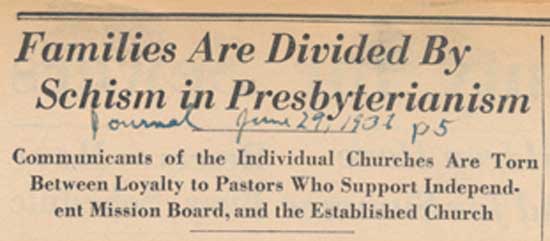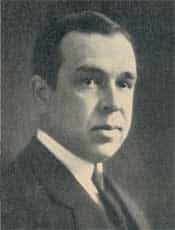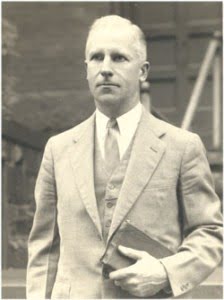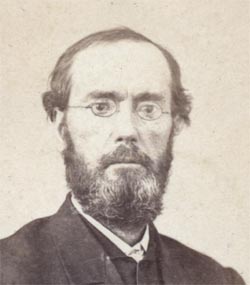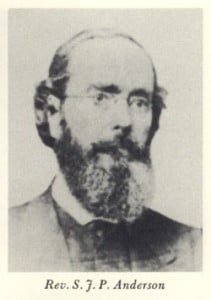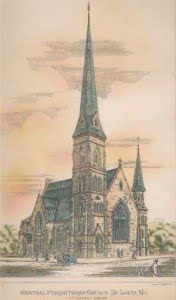As settlers moved ever westward in North America, the problem of planting churches in these new regions forced questions of Christian unity and cooperation. So it was that in 1801 that a Plan of Union was agreed to, first by the Presbyterian Church in the U.S.A. and a year later by the Congregational Association of Connecticut, which would allow a pastor of the one denomination to gather and serve a church of the other denomination. But within some thirty-odd years, the Plan was increasingly seem to be causing problems. For one, the Congregationalists who had been almost unanimously Calvinistic at the turn of the century, were now charged with being infected with elements of heterodoxy, and the influence of these elements was seen as making inroads among Presbyterians. There were other issues and problems, voiced from both sides, and for the Presbyterians, the matter came to a head at the General Assembly of 1837. In the weeks before the Assembly, those opposed to Plan of Union met in conference and drew up a fifteen point Memorial, citing their complaints with the Plan and other matters. These “memorialists” then arrived at the General Assembly, organized and prepared to take action. What follows is E.H. Gillett’s account of that Assembly and the action by the memorialists to bring the Plan to an end. This was the battle between the Old School (the memorialists) and the New School:—
Abrogation of the Plan of Union [1837]
The General Assembly of 1837 met in the Central Presbyterian Church, in Philadelphia, on the 18th of May, and was opened with a sermon by the Rev. John Witherspoon from the words (1 Cor. 1: 10-11), “Now, I beseech you, brethren, by the name of our Lord Jesus Christ, that ye all speak the same thing, and that there be no divisions among you; but that ye be perfectly joined together in the same mind, and in the same judgment. For it hath been declared to me of you, my brethren, by them which are of the house of Chloe, that there are contentions among you.“
The parties into which the Assembly was divided were ably represented. On one side were Rev. Messrs. Breckinridge, Plumer, Murray, and Drs. Green, Elliott, Alexander, Junkin, Baxter, Cuyler, Graham, and Witherspoon. On the other were Drs. Beman, Porter, of Catskill, McAuley, Peters, and Cleland, and Rev. Messrs. Duffield, Gilbert, Cleaveland, Dickinson, and Judge Jessup. The respective strength of the parties was declared in the vote for moderator, the candidate of the former receiving one hundred and thirty seven votes, while the other candidate, Baxter Dickinson, received but one hundred and six. Thus encouraged, the memorialists were confident that they should now be enabled to adopt decisive measures.
The Committee on Bills and Overtures consisted of Messrs. Witherspoon, Alexander, Beman, Cleland, Murray, Todd, and Latta, with four elders. To them along with overtures from Presbyteries on the same subject, the memorial was referred. The report of the committee recommended the adoption of the testimony of the memorialists concerning doctrines, as the testimony of the Assembly. Objection was made. The list of errors noted was fifteen in number. Some members thought that others should be added. One member proposed four others. Dr. Beman thought the list already too long. Of some mentioned in it he had never before heard. It was finally resolved to postpone the question for the present, and to take up the portion of the report bearing upon the Plan of Union.
This subject came before the Assembly on the afternoon of Monday, May 22. It was resolved, first, that between the two branches of the Church concerned in the Plan of Union, sentiments of mutual respect and esteen ought to be maintained, and that no reasonable effort should be spared to preserve a perfectly good understanding between them; secondly, that it was expedient to continue the plan of friendly communications between them as it then existed; but, thirdly, that as the Plan of Union adopted for the new settlements in 1801 was originally an unconstitutional act on the part of the Assembly,—these important rules having never been submitted to the Presbyteries,—and as they were totally destitute of authority as proceeding from the General Association of Connecticut, which is vested with no power to legislate in such cases, and especially to enact laws to regulate churches not within her limits, and as much confusion and irregularity have arisen from this unnatural and unconstitutional system of union, therefore it is resolved that “the act of the Assembly of 1801, entitled a ‘Plan of Union,’ be, and the same is hereby, abrogated.” The vote upon this important measure, which tested the relative strength of the parties in the Assembly, stood one hundred and forty-three to one hundred and ten.
So the Plan of Union was ended. Those interested in reading further in Gillett’s account may click here.
Words to Live By:
In retrospect, Rev. Witherspoon’s opening sermon on 1 Corinthians 1:10-11 was both plaintive and somewhat prophetic of events to follow that week in 1837. While he was a leading voice among the “memorialists,” John Knox Witherspoon [1791-1853] was also the grandson of Dr. John Witherspoon [1723-1794], a prominent founding father of the Presbyterian Church in the U.S.A. Perhaps it was in the light of that heritage and so as something of a statesman for the Church that John Knox Witherspoon delivered his sermon that day, knowing what was ahead, yet hoping for better things. Pray for the Church when self-seeking, bitterness and needless contention arise; stand peaceably for the truth of God’s Word and for the unity of the Body of Christ, remembering that the battle is the Lord’s.
“Now, I beseech you, brethren, by the name of our Lord Jesus Christ, that ye all speak the same thing, and that there be no divisions among you; but that ye be perfectly joined together in the same mind, and in the same judgment. For it hath been declared to me of you, my brethren, by them which are of the house of Chloe, that there are contentions among you.”

